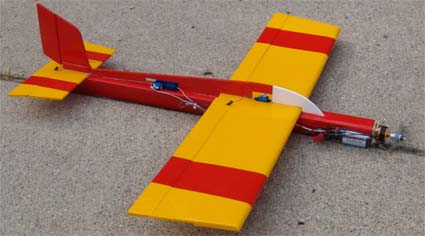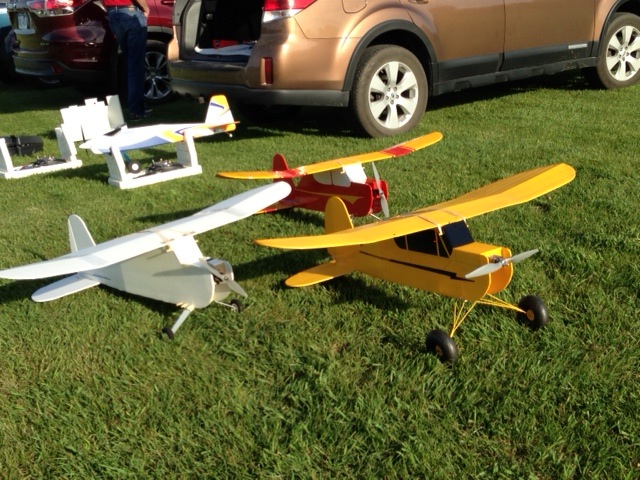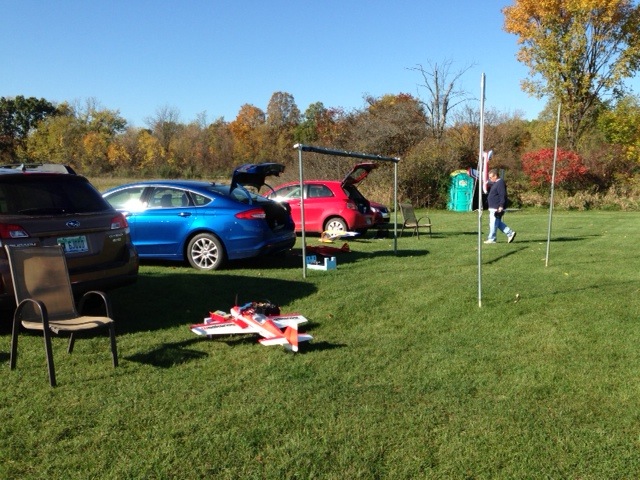 |
Flying High With Electric Power!
The Ampeer ON-LINE!
Fly the Future - Fly Electric! |
|---|
Site Table of Contents
| President: | Vice-President: | Secretary-Treasurer: |
| Ken Myers | Richard Utkan | Rick Sawicki |
| 1911 Bradshaw Ct. | 240 Cabinet | 5089 Ledgewood Ct. W. |
| Commerce Twp., MI 48390 | Milford, MI 48381 | Commerce Twp., MI 48382 |
| (248) 669-8124 | (248) 685-1705 | (2480 685-7056 |
 | ||
| Board of Directors: | Board of Directors: | Ampeer Editor |
| David Stacer | Arthur Deane | Ken Myers |
| 16575 Brooklane Blvd. | 21690 Bedford Dr. | 1911 Bradshaw Ct. |
| Northville, MI 48168 | Northville, MI 48167 | Commerce Twp., MI 48390 |
| (248) 924-2324 | (248) 348-2058 | (248) 669-8124 |
| The Next EFO Meeting: Date: Wednesday, Dec. 14 Time: 7:30 p.m.
Place: Ken Myers' house | ||
| Flightline Hobby's New Location Joe Hass tells us where Flightline Hobby is located now. | AMA Update with District VII VP, Tim Jesky Joe Hass announces the upcoming District VII AMA meeting. |
| Building Airframes with Dollar Tree Foam Board (DTFB) Ken Myers shares what he's learned about using Dollar Tree Foam Board to create airframes. | The October 23 EFO Monthly Flying Meeting Photos and information from the flying meeting. |
| AXI Outrunner Motors Ken shares thoughts and information on AXI outrunner motors. | Innov8tive Designs is on the Move Innov8tive Designs is moving to southeastern Michigan. |
| 2016/2017 Indoor Flying in Brighton Announcement of an Indoor Flying at the Legacy Center in Brighton, MI. | Upcoming Foam in the Dome 2016 - A Toys For Tots Benefit Announcement of an Indoor Flying event in western Michigan. |
| Oh RATS! I KILLED IT! Ken describes a somewhat costly lesson. | |
From Joe Hass via email October 23, 2016 I received the following from Joe at the end of October, so the move has happened. This is my favorite area hobby shop, and well worth the drive for me. KM John Hoover asked my to pass on this important message. PLEASE PASS THIS ON! Flightline Hobby will be opening in their new location at 11AM on Wednesday October 26, 2016. Here is the new address: Flightline Hobby
Flightline is now located in the Walden Pond Shopping Center on the Southeast corner of Baldwin and Waldon. If you take I-75 north exit at the Baldwin Road exit. Turn right heading north. The mall will be on your right. Congratulations John and Tracie. Thanks for serving the modeling community! Joe Hass
AMA Update with District VII VP, Tim Jesky
Ken, Please pass this along. I anticipate that there will be a local Goldberg Vital Person Award announcement. Join us for an informative evening concerning topics of interest to the aeromodeling community. Thanks.
Monday, November 28, 2016
Latest From the AMA & FAA Ultimate Soccer Arenas
New Products, Special Guest & Pilots' Prizes No Charge to Attend Sponsored by
For More Information contact:
Return to "What's In This Issue" Building Airframes with Dollar Tree Foam Board (DTFB)
The following is a synopsis of a presentation that I made at the October 2016 Midwest RC Society meeting. KM There are a lot of different 'foams' used in the construction, or partial construction, of RC airframes. Building and Flying Electric Sport Scale
Keith noted several uses for 3/16" foam board (foamboard) in his beautiful scale planes.
There is a wonderful material called foamboard. It can be purchased at art stores. It's basically 3/16" foam with index card bonded to both sides. It has no apparent grain. Therefore, great big holes can be cut out of it. It weighs about the same as 3/32" balsa. It's a little thicker. Virtually every single airplane I fly has bulkheads made of foamboard. The only drawback is that you MUST use RC56 glue. I haven't cut a balsa bulkhead in many, many years. I just don't know how to cut balsa bulkheads without grain fractures. Weldbond sticks to the foamboard. If you use epoxy, or typical white glues, it makes a very hard joint, causing a delamination failure. Weldbond All Purpose Adhesive, (identical to RC56), can be purchased from a hardware store. It's a milky white liquid that smells a little like vinyl. It's actually a polymer. You can use that to glue the foamboard to the balsa. The bulkheads can be cut on a band saw. Just treat it like balsa. On great big airplanes, I've used it for ribs - I mean 14 foot wingspan. In the forward fuselage there are usually enough stringers for strength. Use some sort of balsa block for the nose with another bulkhead just aft. With foamboard half shell fuselages, on every bulkhead, somewhere in the middle, like with the crutch, set up a place where there is going to be a pair of lengthwise 1/8" x 3/8" pieces of spruce. All of the outer structure is gong along for the ride. It is just there to make the model look like a real airplane. The inner structure is carrying the load. Since the bulkheads are load bearing, face small areas of the bulkheads with 1/64" ply to help carry the load. The load goes from the strips to the 1/64" ply and is transmitted across a larger surface of the foam board, tying them together, distributing the load. 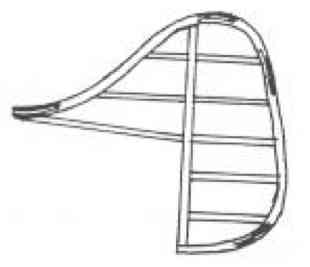 To make a curved tail outline with straight pieces is a pain. Making a laminated tail is easier. Use a piece of foamboard and undercut the outside dimensions by about 1/4". Cut strips of 1/16" X 1/4" balsa and stack it up with white glue between the laminations, wrap it around the foamboard and tape it in place. Let it dry, take the tape off, pin it down and fill in inner structures. You can use 1/32" strip for the really small airplanes. It is very strong, like eggs and circles. It weighs virtually nothing. 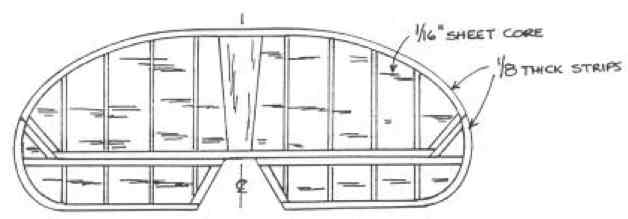 If you don't want to do all that, you can use the "core" method, leaving the foam board inside.  Turn it over and repeat on the other side. Sand it to section. My History
In 2009 I built a foam board airframe based on Carlos Reyes' Modifly. It used a KFm1, bottom-stepped, flat-plate type airfoil. The hardest part of building it was removing the 'card stock' to just use the foam. The parts had to be soaked in my bathtub to remove the 'card stock'. The 'card stock' on Dollar Tree Foam Board peals off easily. Some might say, too easily. The plane flew okay, but not great. In December of 2015 I started a project where I was learning more about LiPo batteries. I'd purchased a lot of 3S 1000mAh batteries, but had no plane to fly them in. I wanted something really simple to build. I remembered that EFO vice-president Richard Utkan and EFO member Owen Morgan had brought Dollar Tree Foam Board (DTFB) planes to EFO meetings. In January of 2015, Richard shared his Flitetest Old Speedster. 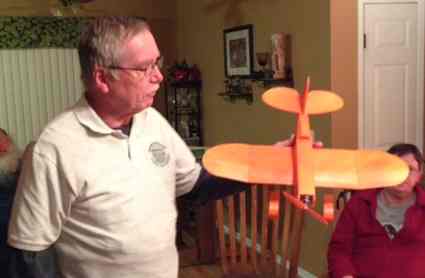
EFO vice-president Richard Utkan with his FliteTest (FT) Old Speedster The previous March, Owen Morgan shared his Flitetest Spitfire. 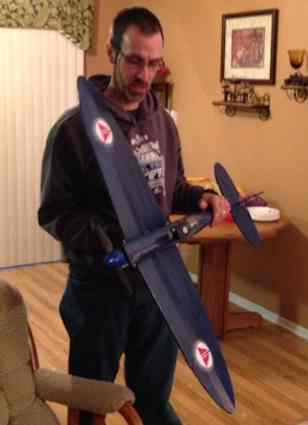
EFO member Owen Morgan with his FliteTest (FT) Old Spitfire Their successful planes, constructed of this, new to me, building material, intrigued me. I started searching and researching Flitetest. DTFB is a bit less than 3/16" thick light foam covered with craft paper-like card stock.It costs $1.00 per sheet at Dollar Tree stores. Its proper name is, "Readi-Board, FOAM BOARD, ADAMS, R.L. ADAMS Plastics, Inc., Wyoming, Michigan 49519". It is said to be 30 inches by 20 inches, but it is NOT! For 12 example pieces, the supposed 30" length was never 30". It averaged 29-13/16", give or take a little each way. The 20" width never measured 20". It ranged from 19-15/16" to 20-5/32". Those dimensions are really only important for scratch designers and builders when they are laying out parts. It is approximately 0.177" (4.5mm) thick. It weighs, with the craft 'card stock' on it, about 0.19 grams (0.0067 ounces) per square inch or 26.9 grams (0.95 ounces) per square foot. The average weight for the average 599 square inch sheet was 113.3g (4 ounces). The typical, 0.215" (5.5mm) thick , foam board sold at Meijer, Walmart and craft stores weighs about 219.5g (7.75 oz.) per sheet or 52.85g (1.86 oz.) per square foot.
I decided that the simple looking Flitetest Old Fogey, enlarged 1.22 times for my 3S 1000mAh packs, would make a good learning project. Since I quickly learned that I could not use my wife's hot melt glue gun and glue, it was the wrong type gun and glue, FOAM-TAC, basically a type of contact adhesive, was used throughout the construction, and many, many reconstructions of the prototype. The reconstructions were caused by the Old Fogey being and almost unflyable design! DTFB allows modifications to be made easily, quickly and cheaply. There were a lot of modifications needed to my Old Fogey! Once the prototype was flying reasonably well, a completely new second version was created. The second version included all of the modifications I found necessary, and it was covered with TopFlite EconoKote, which worked very well. Video of the final prototype Old Fogey 1.22x flying. During the time I was working on the Old Fogies, I was learning more about DTFB. Besides FliteTest, I found several sources of information on RC Groups and the Internet with DTFB tips, tricks, and plans for airframes. On RC Groups, in the Foamies (Scratchbuilt) section there is a sticky named Foamboard Scratchbuild University. There are also a lot of threads in that forum with the words Dollar Tree Foam, FliteTest or FT and DTFB in the title. A search of the forum using those and similar words will bring them up. Later in the year, I decided I would like to have a flying discharger for the left over charged LiPo batteries from training sessions where I did not use all the batteries that I had charged. I looked at several possibilities. Something with an "Armin Wing"? 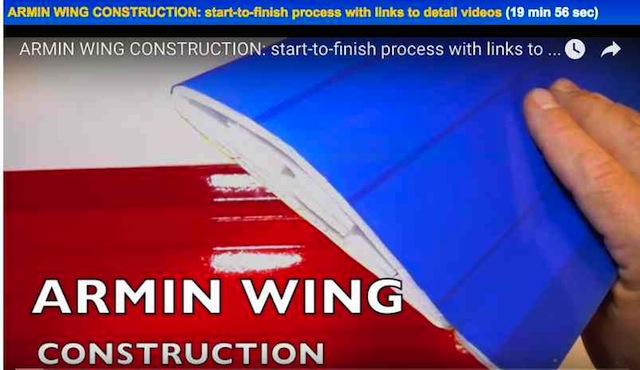 No, I didn't really want a flat bottom wing, and I really did not like the construction. The FliteTest (FT) Racer, Slinger version  No, I didn't care for the wing construction. While watching the video for the FT Baby Blender v2 build, I saw a construction technique more to my liking. Wing construction starts at about 19 minutes into the video. 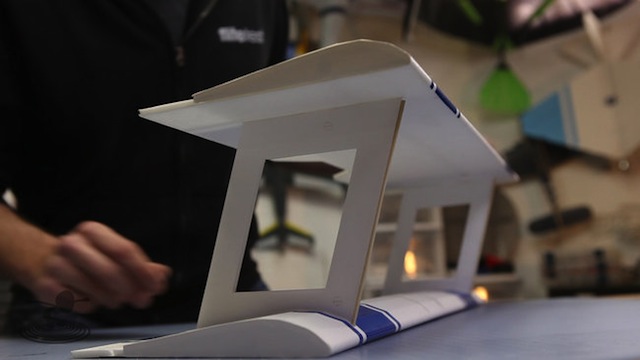 While the airfoil was not what I was looking for, part of the technique seemed like it should work and would be able to make a symmetrical or semi-symmetrical airfoil. I decided to try to create an Ugly Stik based on the original Phil Kraft design. 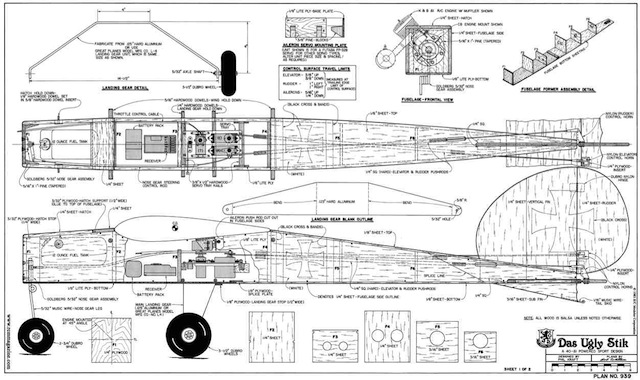 The original version of my Stik used the identical proportions of the Phil Kraft design. A Clark-Y airfoil was chosen, although not used on the original. Once the wing was 'designed' in CAD, a span shortened full-size prototype model was made. The original design was later modified, but proved that I could make a Clark-Y airfoil using DTFB. The whole design went through several changes, including a completely new, longer fuselage, 3/16" plywood firewall and new vertical fin and rudder. The final change was modifying the angle of incidence, by decreasing it, right on the second fuselage, so that they plane would not climb too much at full power. Again, the modification was fairly easy right on the previously finished and the now flying fuselage. 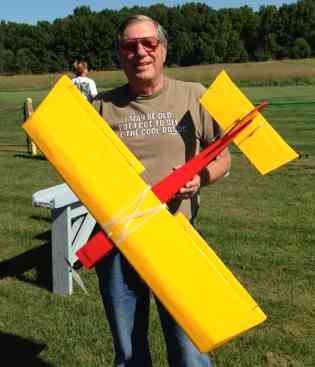 The airframe was covered with TopFlite EconoKote. I measured the weight of the airframe before applying the covering and again after. The EconoKote covering added 44.5g (1.57 oz.) to the overall weight of the airframe. The wing area is approximately 340 sq.in. or 2.36 sq.ft. The covering added about 0.66 oz./sq.ft. I'm pretty sure using colored packaging tape, an often used technique for DTFB covering, would have added that much, or maybe more, weight. Adhesives I've Used
Other Construction Materials Used Besides DTFB
Construction Tools
Be careful where parts are laid if spray adhesive is use to affix templates to the foam board. It will pick up bits of 'stuff' after the template is removed. Adding pull strips to the paper templates, that have no spray adhesive on them, makes the templates easier to remove. Use Great Planes control horns. They use Phillips screws instead of straight slots. On Tuesday, October 4, I remembered that I had forgotten a reference that I'd run across. It was for Nic Lechner AKA nerdnic. I watched is video about the design of what he calls his 'nnSpeedwing'. I believe the wife heard the forehead slap upstairs. The technique was basically the same as mine. Duh. There are some technique differences between our two methods. Instead of using a few 50% cut lines in front of the spar on both the top and bottom inside the wing area, I removed the paper/'card stock' between the front of the spar and leading edge on both the top and bottom and gently encouraged the foam to bend in the direction I wanted before actually gluing the top of the wing panel in place. I also built a capture 'spar' to align with the rear of the top spar to help in alignment. My leading edge was created using a Phillips head screwdriver. I put my servos on the outside of the wing. He used a hot melt glue gun and I used Titebond, pins and bricks. For the type of wing on the Stik, I used 'actual' built on wing tips. Even with the differences between nerdnic's method and mine, overall, his ideas are really good. I plan on using them in my next build, as the plane I have in mind has the same 'shape', but it will have landing gear in the wing. Note: I did find out why I didn't run across Nic's video when doing earlier research. It was not posted until September 26, 2016. During Ken's question and answer session, Norm Peters shared some DTFB construction ideas for his latest project. They included a wing structure with ribs, how to 'strengthen' certain areas, like leading edges and control surface facing areas, using bass wood and balsa and how to 'form' DTFB in shapes for cowlings, turtle decks, etc. Thank you Norm! Update: Since that time, I've flown the DTFB full airfoil Stik quite a bit. I did some 'crash testing' on the evening of Wednesday, October 19. (Gotta hate dumb thumbs!) There was only a broken propeller and some damage to the front of the fuselage. In a short amount of time, the firewall was glued back on again, and a few cracks in the forward part of the fuselage, were also glued back together. I was surprised that the foam board cracked. Yes, it wrinkled, which I had expected, but I was surprised by the cracks. Some EconoKote was ironed on over the patches, and its flying as well as ever. I was pleasantly surprised that the plane needed no trim changes on the transmitter after the repairs. The October 23 EFO Monthly Flying Meeting
We finally got a very nice weekend day for our monthly EFO flying meeting. Sunday was a perfect fall day. The temperature started out at about 50 degrees F, but rose to the mid-60s quite quickly. The wind cooperated, and stayed reasonably calm until about 2 p.m. Greg Eilers can be seen walking back to his car in the first photo. Ken's planes are behind his Subaru. Both Ken and Pete Foss had their Hitec Weekender Extras out and flying. 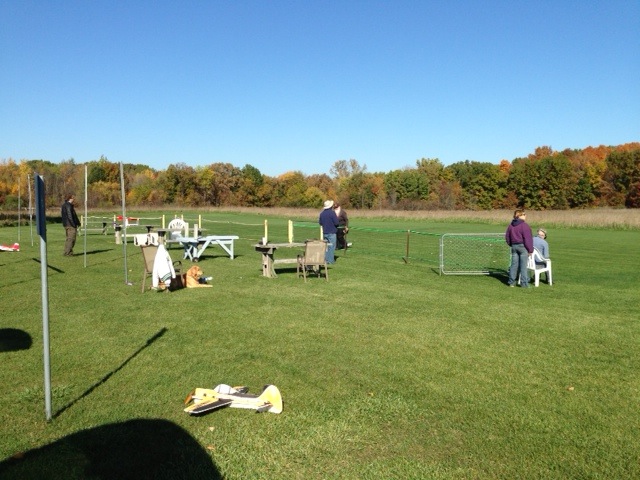 The beautiful sky and changing leaves can be seen in this photo of the flight line activity. 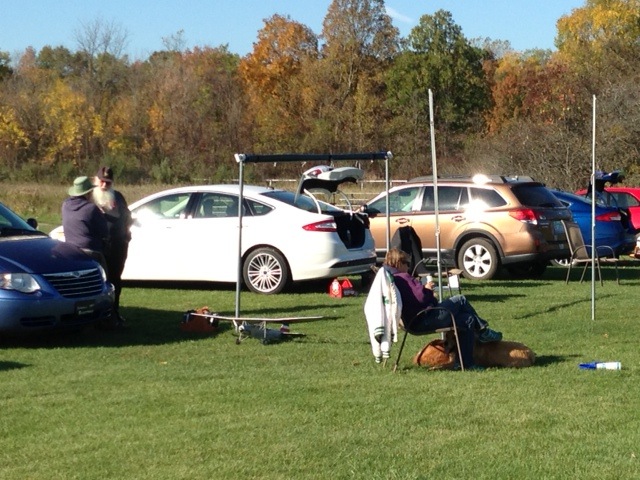 Keith Shaw and Arthur Deane discuss the benefits of tailless, flying wing aircraft while Carolynne Foss sits above the dogs at a flying field. They are the best flying field dogs in the whole world. As usual, there was a lot of good flying and camaraderie. Denny Sumner sent some links to video taken on the 23, along with the following note: I uploaded my videos from yesterday along with a "hatcam" test I did earlier this Summer.
Hatcam
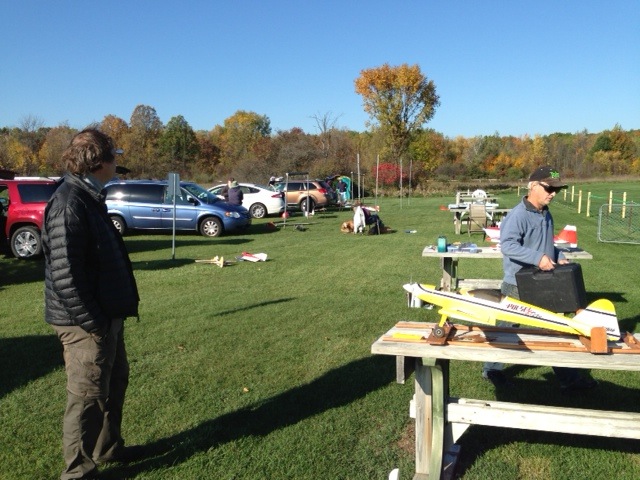
Mark Couling looks on as Pete Foss sets up for a great day of flying. Arthur Deane's Pulse 25 is setting on the table, ready to go. We'll just have to see what November brings here for weather in southeastern Michigan. Hopefully, at least one more great day. Return to "What's In This Issue" AXI Outrunner Motors
On October 28, 2015 I received an email from Hobby Express, formerly Hobby Lobby International. It included the following graphic and a link to the AXI outrunner motors, produced in the Czech Republic by Model Motors.  I misunderstood what it said in the graphic to mean that they would no longer be carrying these excellent outrunners. I double checked and found that they are carrying the V2 version of these motors, and they have only the original versions On Clearance Sale. Whew. The fine quality AXI outrunners were the first ones I used. Every single AXI I own is still in service today, except for a 2820/10, which was traded away, as it appeared to be a mislabeled 2820/8. Some articles that have appeared in the Ampeer: Sometimes You Find What You're Not Looking For, Ken notes that Rob Smith's "Sport Electrics: Techniques" column in the October 2004 Quiet Flyer had excellent info regarding the AXI 2212/26. The Meaning of Some Brushless Motor Designations, Ken explains how AXI outrunners are named. Comparison of AXI 2212/26 and Top Creations 22S4019A Geared 5.28/1, Warren Plohr agrees with Ken's evaluation of an outrunner compared to an inner runner. What In the World is Going On with AXI/Model Motors?, Ken explains the problem he had with a 2820/10. More on AXI/Model Motors, Don Belote and Jim LaLone add information on this motor that Ken had big problems with. AXI_Calc, Louis Fourdan let's folks now about his program. MM_Calc AXI, Louis Fourdan links to his motor calculation software. Back in 2005 and 2006 I was a huge AXI fan for the same reason that I have become a huge Scorpion and Cobra fan; they provided real world data regarding prop and battery selection. Unfortunately for AXI, and maybe myself, I moved on to the outrunners provided by Lucien Miller of Innov8tive Designs, but AXI motors are still well made and very useful. You might still want to consider AXI when selecting the motor for your next project, and you'll be able to get it at Hobby Express. Innov8tive Designs is on the Move On October 17, I received an email from Innov8tive Designs. The email was mainly about a HUGE sale Lucien was having at the California warehouse, but for me, the interesting part was, "Since Innov8tive Designs was founded in 2006, we have been serving the RC modeling community with the finest Electric Power System products and accessories available. We have been at our current location in Vista, California since June of 2009. At the end of November this year, we will be relocating the company back to Monroe, Michigan, the home town of Innov8tive Designs President and founder Lucien Miller." Wow, that is in our backyard here in southeastern Michigan. Welcome back Lucien!!! 2016/2017 Indoor Flying in Brighton
Just a reminder that indoor flying at the Legacy Center starts weekly this Wednesday, November 2nd at 1:00 PM. Here is the information from the Legacy Center, 9299 Goble Dr, Brighton, MI 48116: November 2nd - March 29th The drop-in fee will be $10/day. We are no longer charging our $15 annual facilities fee, so those who purchased one last year will still be able to pay $5/day until their membership expires. At which point they will have to pay $10/day. I would also like to stress that drop-in does not begin until the posted time. We need to be strict with the allotted time frame. If space allows, and someone wants to stay after the posted end time they must pay an additional $10. Upcoming Foam in the Dome 2016 - A Toys For Tots Benefit
West Michigan Park Flyers LLC has contacted the Golf Dome in Schoolcraft, Michigan and persuaded them to open the doors for indoor flying this winter for a Toys For Tots Fun-fly. Price of admission is $30.00 to fly all day. Or $20.00 and a new toy for donation. The Dome is 150 ft. x 200 ft. with a 65 ft. ceiling. Plenty enough room for a lot of planes and a whole lot of fun! We are putting on a one day event this winter, as well as some off hours flying, with the anticipation of expanding it to a 3 day Holiday fun Fly next year. Next years event will depend on how successful the one days participation is this year. Please help spread the word to your club members. Events will include:
Vendors:
Food:
Flying Schedule:
December
January
February
All proceeds from Pilot fees minus Toys For Tots go to the dome to help keep it open for indoor flying. Thanks and Happy Holidays,
Update email 10/29/2016 During the event we will be passing on the savings to all our customers worldwide. Even if you are all the way on the other side of the country or local, you can still get in on the savings. Your Savings during the event will be 10% off all kits! Just place your order online during the event and SAVE! Just in time for your Christmas shopping. Online registration is now open for Foam In The Dome. The first 50 pilots that pre-register will get the following gift packet. See Foaminthedome.com to register now!
Your packed of goodies will be waiting for you when you arrive. Oh RATS! I KILLED IT!
On Friday, Oct. 28, 2016 I killed a LiPo battery. I used a couple of LiPo packs to carefully check to see if the latest firmware upgrade, 2.27, had changed the problem with my Revolectrix Gt500 charger yielding spurious results for individual cell IR. It didn't, but that's not the story. 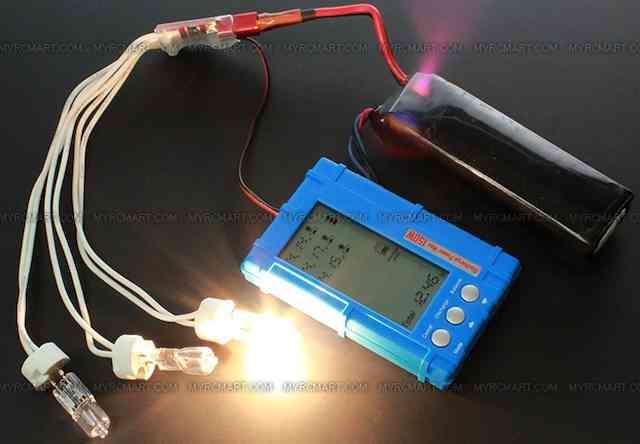 Everything went fine returning the first pack to storage voltage using the RCX 3-in-1 Battery Balancer, Discharger & Voltage Indicator (150W Discharging). Unfortunately, the discharger does not stop discharging on its own. I forgot and left the second battery connected all night! In the morning, I found the cell volts at; 3.115V, 2.25V, 3.205V. I took the duff pack outside to the gravel drive and hooked up my 3 bulb halogen discharger to totally discharge it. Once completely discharged, the balance leads were removed and it was placed in the trash. Lesson learned, write myself a note, and pin it on me when I have something going on in the basement! To Reach Ken Myers, you can land mail to the address at the top of the page. My E-mail address is: KMyersEFO@theampeer.org |
